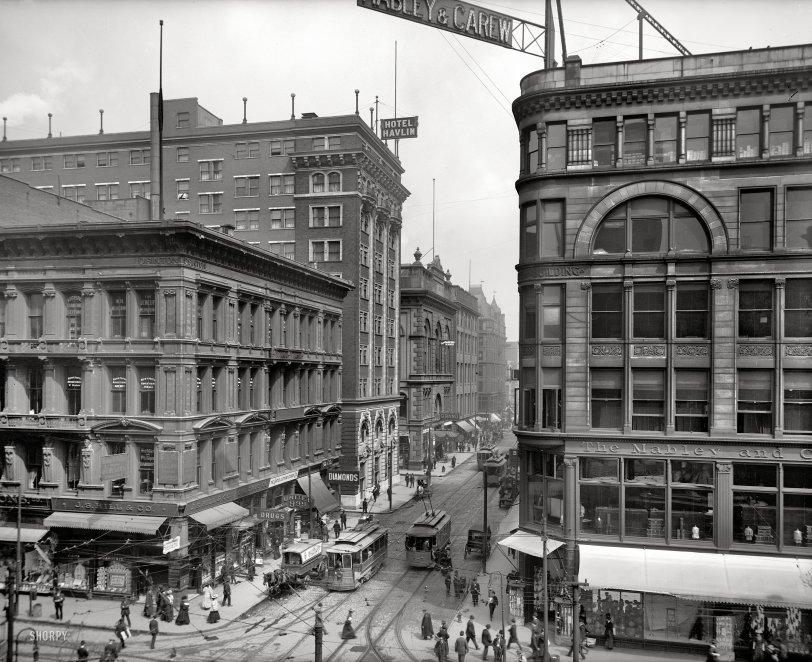


Framed or unframed, desk size to sofa size, printed by us in Arizona and Alabama since 2007. Explore now.
Shorpy is funded by you. Patreon contributors get an ad-free experience.
Learn more.

- Baldwin 62303
- Baldwin VO-1000
- Cold
- No expense spared
- Tough Guys
- Lost in Toyland
- And without gloves
- If I were a blindfolded time traveler
- Smoke Consumer Also Cooks
- Oh that stove!
- Possibly still there?
- What?!?
- $100 Reward
- Freeze Frame
- Texas Flyer wanted
- Just a Year Too Soon
- WWII -- Replacing men with women at the railroad crossing.
- Yes, Icing
- You kids drive me nuts!
- NOT An Easy Job
- I wonder
- Just add window boxes
- Icing Platform?
- Indiana Harbor Belt abides
- Freezing haze
- Corrections (for those who care)
- C&NW at Nelson
- Fallen Flags
- A dangerous job made worse
- Water Stop
Print Emporium
Mabley and Carew: 1907

Circa 1907. "Vine Street at Fifth, Cincinnati." A buzzing hive of commerce featuring a department store, hotel, jeweler, "dancing academy" and ice wagon. 8x10 inch dry plate glass negative, Detroit Publishing Company. View full size.
Grounded
A single wire system requires a connection to ground to complete the circuit between the car and power plant. While saving copper costs, the system could damage metal fixtures in the ground as currents flowed through them (electrolysis) and rainy days might rob current from the "hot" overhead wire and shunt it directly to earth before it could be used by the car. Ground loops played havoc with such systems.
I read a story somewhere that when a single-wire system car got onto a section of track that had somehow lost its ground connection, a passenger stepping onto the car, completed the path to earth, and received a severe shock! I am sure that was rare.
Double Trolley Poles and Cowcatchers
The city of Cincinnati required the trolley company to use the two wire collection/return system. Normally, trolleys used just one pole with the current to run the cars picked up from the wire and returned to the power station through the rails. Cincinnati officials feared that the current in the rails would induce corrosion in underground utilities (water, gas and sewer lines) and demanded the use of two wires to supply and return the current. The cars switched to one pole at the city limits.
The "cowcatcher" was a device to keep errant pedestrians from falling under the cars and being injured or killed by the underhung motors or the trolley's wheels. They were actually called "fenders". Some varieties automatically stopped the car if they hit an obstacle, providing the advantage of the car not derailing.
The Hotel Sinton
was at 4th and Vine. Built 1907, demolished in 1967 - it was named after David Sinton. I lived in Cincinnati in the early 1960s and remember it as an empty hulk. Its claim to fame is that it was the site of the meeting which led to the Black Sox scandal of 1919.
Wondering
This was my family's hometown at the time of the picture -- I wonder if any of the dapper folks on the street are my relatives. We have a lot of street-level snapshots of this area from the 1910s - 1940s.
Details
It appears that the operator of trolley #16 is adjusting the switch he has to pass through before proceeding on his route. I always wondered how that was done.
The two pole system seems uncommon in most trolley photos. Our local transit company used to operate trolley buses with a dual pole system but when they ran streetcars they were single pole. Advantages to the dual wire system would probably include winter operations (unless the wires were coated with ice) but the downside would be that the cost of the system would increase as you'd need twice as much copper wire.
From diamonds to drugs
This street has everything!
Anti-Bovine Apparatus
I guess in modern 1907 you still had the occasional stray
cow wandering around in the city. A factory option when you
purchased a new streetcar no doubt. On second thought, most of their close encounters of the cow kind probably happened when they reached the suburbs.
[Also those pedestrians who wouldn't moo-ve. - Dave]
Every Kind of Hat For Every Need
as long as you need a bowler.
But I guess that isn't much different from baseball hats, today.
Diamonds and Towers
Richter and Phillips, a very upscale jeweler is still going strong in Cincinnati, and Joe Carew, of Mabley & Carew, did quite well for himself. Until recently the Carew Tower, which replaced the store, was the tallest structure in the Queen City at 49 stories. It is a beautiful Art Deco style building.
Massive pivot window sashes
Windows on second floor of building to the right. Those upper-center pivoting sashes must be about six feet wide. Some of the project-out casements look large too. Wonder how such windows fared in really windy days? Love the fenestration technology/ styles used at the time.
Perfect
All those windows on the top floor of the Mabley building and it is their stockroom for shoes, based on the size of the boxes you can see. Anyone know what the name "D. SINTON" on the building at the left refers to.
[The "block names" surmounting the era's business-district buildings are the people who financed their construction. The Sinton Block, which included the Hotel Sinton, was put up by the industrialist David Sinton. - Dave]
























On Shorpy:
Today’s Top 5